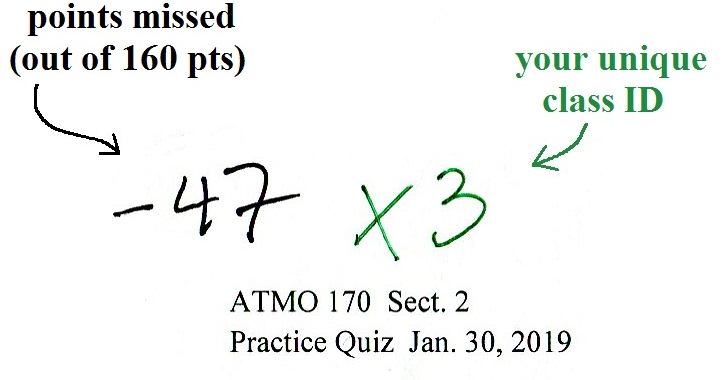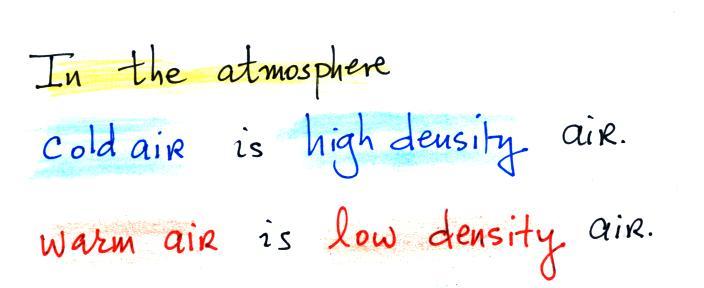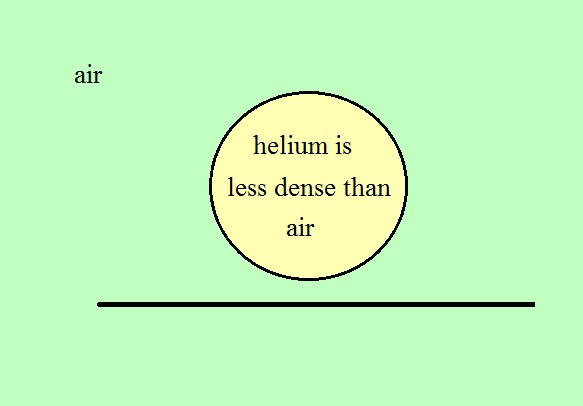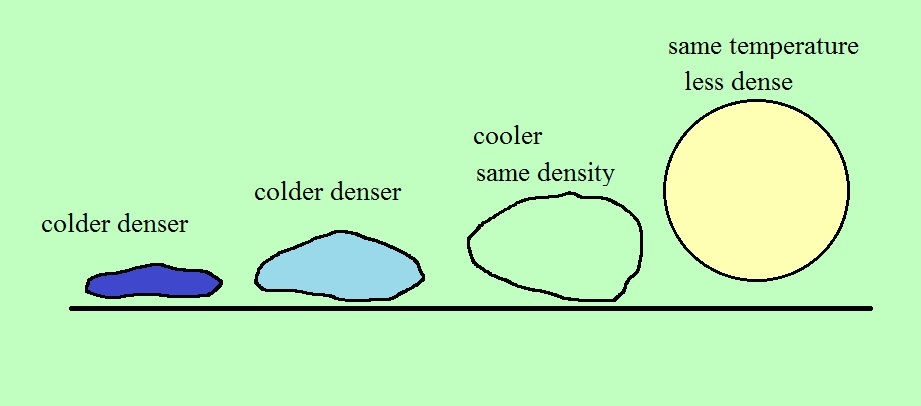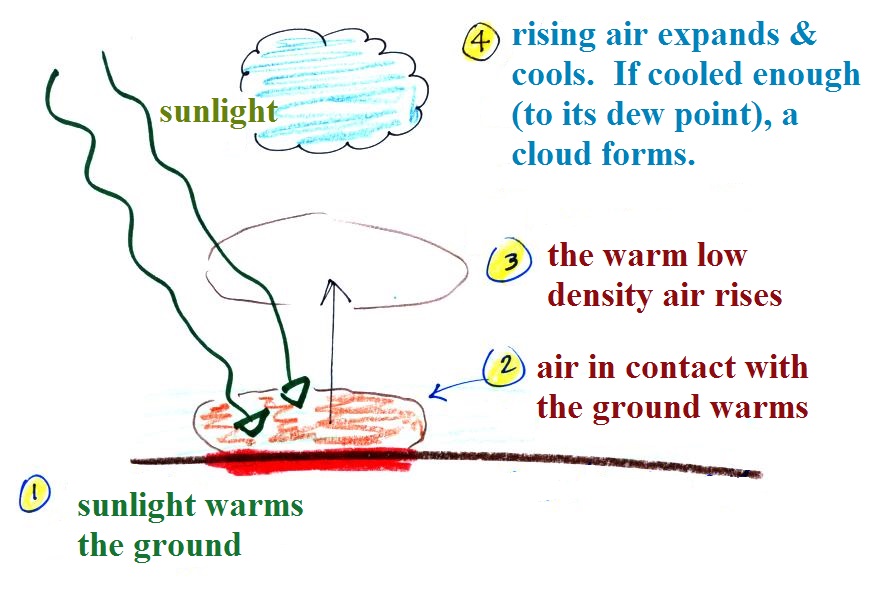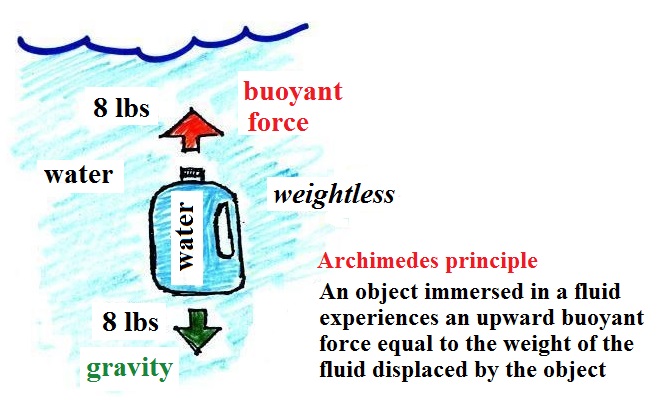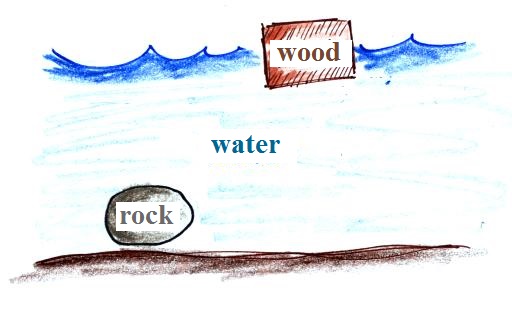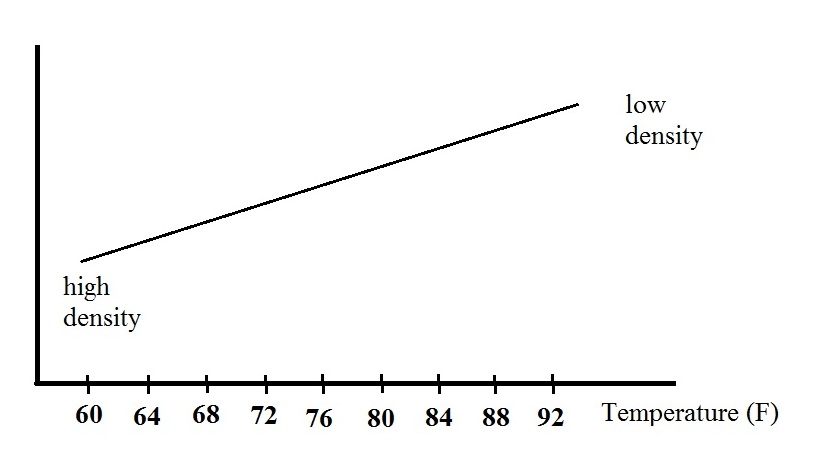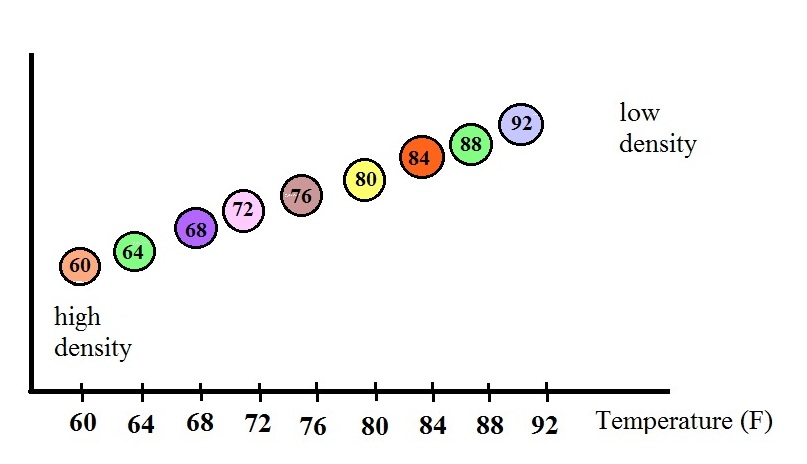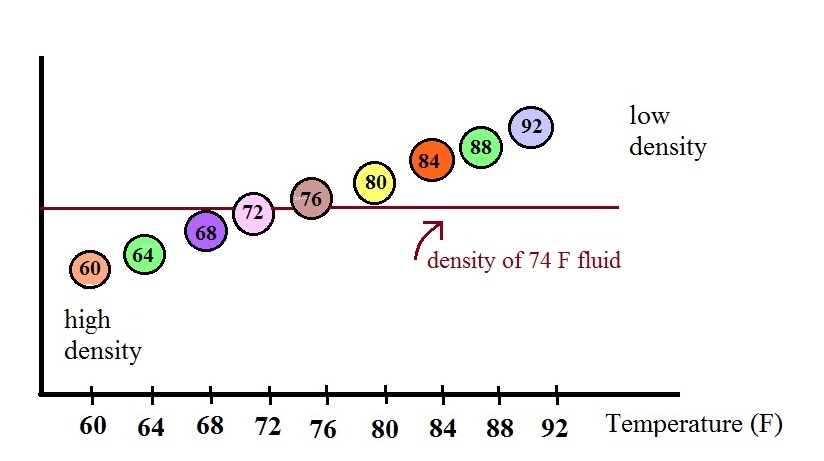Friday, Feb. 1, 2019
Lissie "Don't You
Give Up on Me" (4:04), "They All
Want You" (4:14), "Record
Collector" (4:14), "In Sleep"
(5:23) part of a set at the end of the Guitar
Center's Singer/Songwriter 2 Competition Finals at Hotel
Café in Hollywood (Mar., 2013)
We'll use page 53, page 54, page 54a, and page 54b.
The
Practice Quiz has been graded and was
returned in class today. The
average score was 71%, which is a
little higher than
normal. Scores from
a few recent classes are shown below
Semester
|
Average grade
|
Semester
|
Average grade
|
Sprg 2019 8 am MWF
|
79%
|
Sprg 2019 9 am MWF
|
71%
|
Fall 2018 8 am Tue Thu
|
67 %
|
|
|
Sprg 2018 8 am Tue Thu
|
59%
|
Sprg 2018 9 am MWF
|
64%
|
If you missed the Practice Quiz you can
download a copy here.
I would suggest you do that if only to get
familiar with the quiz format. You
can take the quiz just as if you were in
class. Here are answers
to the questions so that you can see how
well you did.
In
addition to your score you'll find your
unique Class ID. That will allow you
to check you class grade online once we're
a little further along in the semester.
This is about where we left off on Monday.
Step #3 Two vertical forces acting on a parcel of air in the
atmosphere
(see p. 53 in the ClassNotes)
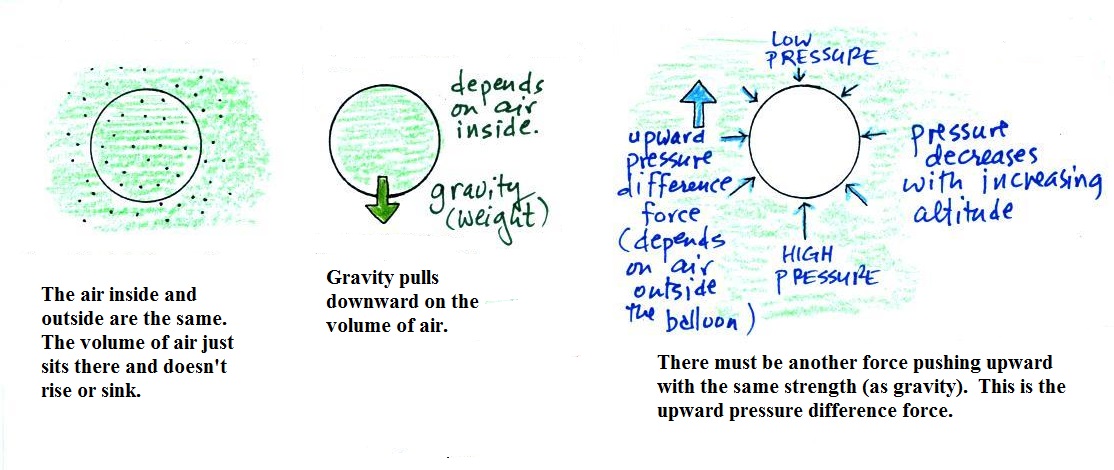
Basically it comes down to this - there are
two forces acting on a parcel of
air in the atmosphere. They are shown above.
The first force is gravity, it pulls downward. Most
everyone knows about this force. The strength of the
gravity force (the weight of the air in the parcel) depends on
the mass of the air inside
the parcel.
Second there is an upward pointing pressure difference
force. Not too many people know about this one. This
force is caused by the air outside (surrounding) the parcel.
Pressure decreases with increasing altitude. The pressure
of the air at the bottom of a parcel pushing upward is slightly
stronger than the pressure of the air at the top of the balloon
that is pushing downward. The overall effect is an upward
pointing force.
When the air inside a parcel is exactly the same as the air
outside (same densities), the two forces are equal in strength
and cancel out. The parcel is neutrally buoyant and it
wouldn't rise or sink, it would just hover.
We'll replace the air inside the balloon with
either warm low density air or cold high density air.
In the first case, a balloon with warm low density air won't
weigh as much. The gravity force is weaker. The
upward pressure difference force doesn't change (because it is
determined by the air outside the balloon which hasn't changed)
and ends up stronger than the gravity force. The balloon
will rise.
Conversely if the air inside is cold high density air, it
weighs more. Gravity is stronger than the upward pressure
difference force and the balloon sinks.
It all comes down to a question of how the density of the air
in a parcel compares to the density of the air surrounding the
parcel. If the parcel is filled with low
density air it will rise. A parcel full of high density
air will sink. That's true of things other than air.
Wood floats in water because it is less dense than water.
Here's a short demonstration of the role
that density plays in determining whether a balloon will rise or
sink (or hover)
Convection demonstration
We used balloons filled with helium (see
bottom of p. 54 in the photocopied Class Notes).
Helium is less dense than air even when it has the same
temperature as the surrounding air. The downward
gravity force (weight of the helium filled balloon) is
weaker than the upward pressure difference force. You
don't need to warm a helium-filled balloon to make it rise.
We dunk the helium filled balloon in
liquid nitrogen to cool it off. When you pull the balloon
out of the liquid nitrogen it has shrunk. The helium is
denser than the surrounding air. I set it on the table (dark
blue above) and it just sat there.
As the balloon of helium warms and expands its density decreases
(light blue). For a brief moment it has the same density as
the surrounding air (green). It's neutrally buoyant at this
point. Then it warms back to near room temperature where it
is again finds itself less dense than the air and lifts off the
table (yellow).
Free convection
Free convection is one way of causing rising air motions in the
atmosphere. We will soon see that rising air is important
because it can lead to cloud and storm formation.
Sunlight shines through the atmosphere. Once it reaches the
ground at (1) it is absorbed and warms the ground. This in
turns warms air in contact with the ground (2) As this air
warms, its expands and its density starts to decrease (pressure is
staying constant). When the density of the warm air is low
enough (lower than the surrounding air), small "blobs" of air
separate from the air layer at the ground and begin to rise, these
are called "thermals." (3) Rising air expands and cools
(we've haven't covered this yet and it might sound a little
contradictory). If it cools enough (to the dew point) a
cloud will become visible as shown at Point 4. This whole
process is called convection; many of our summer thunderstorms
start this way.
Archimedes' principle
Here's another way of trying to understand why warm air
rises and cold air sinks - Archimedes Law or Principle (see pps
54a & 54b in the ClassNotes). It's perhaps a
simpler way of understanding the topic. A gallon bottle of
water can help you to visualize the law.

A gallon of water weighs about 8
pounds (lbs). I wouldn't want to carry that much water on
a hike unless I thought I would really need it.
Here's something that is kind of surprising.
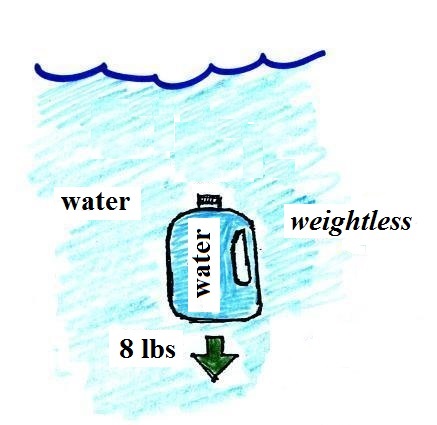
If you submerge the gallon of water
in a swimming pool, the jug becomes, for all intents and
purposes, weightless. The weight of the water (the
downward gravity force) doesn't just go away. Once the
jug is immersed, there must be an upward force of some kind,
one that can cancel out gravity. Archimedes'
recognized that this would happen and was able to determine
how strong the upward force would be.
The strength of the upward buoyant force is the weight of
the fluid displaced by the bottle. In this case the 1
gallon bottle will displace 1 gallon of pool water.
One gallon of pool water weighs 8 pounds. The upward
buoyant force will be 8 pounds, the same as the downward
force. The two forces are equal and opposite.
What Archimedes law doesn't really tell you is what
causes the upward buoyant force. You should know what
the force is - it's the upward pressure difference force.
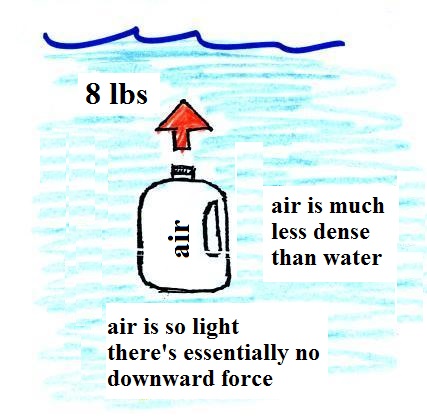
|

|
| We've poured out the water and filled
the 1 gallon jug with air. Air is much less dense
than water; compared to water, the jug will weigh
practically nothing. But it still displaces a gallon
of water and experiences the 8 lb. upward buoyant
force. The bottle of air would rise (actually it
shoots) up to the top of the pool. |
The density of the material inside and
outside the bottle are the same. A bottle
filled with water is weightless. |
Next we'll fill the bottle with something
denser than water (I wish I had a gallon of mercury)
|

|
| Sand is about 50% denser than
water. The weight of a gallon of sand is more
than a gallon of water. The downward force is
greater than the upward force and the bottle of sand
sinks. |
|
You can sum all of this up by saying anything
that is less dense than water will float in water, anything
that is more dense than water will sink in water.
Most types of wood will float (ebony
and ironwood will sink). Most rocks sink (pumice is an
exception).
The fluid an
object is immersed in doesn't have to be water, or even
a liquid for that matter. You could immerse an
object in air. So we can apply Archimedes Law to
parcels of atmospheric air.
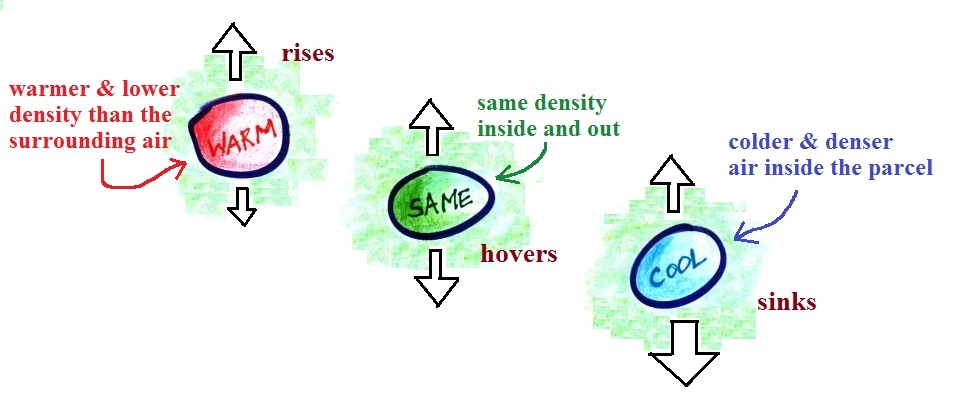
Air that is less dense (warmer)
than the air around it will rise. Air that is more dense
(colder) than the air around it will sink.
Here's a little more
information about Archimedes.
I want to show one last application of
some of what we have been learning - a Galileo
thermometer. That's assuming it survives the trip from
my office to our classroom. It's a fairly new
acquisition of mine and is fragile.
The left figure above comes from an
interesting and informative article in Wikipedia. The
right figure is a closeup view of the thermometer I brought to
class.
Here's an explanation of how the thermometers work. It
requires some time to process.
Just like air, the fluid in the thermometer will expand slightly
if it warms. It will shrink when it cools.
The changes in the volume of the fluid will change the fluid's
density. The graph above shows how the fluid density might
change depending on temperature. Note lower densities are
found near the top of the graph (the fluid expands as it warms).
The colored balls in the thermometer all
have slightly different densities. They also have little
temperature tags. The 60 F ball has a density equal to the
density of the fluid at 60 F. The 64 F ball has a
slightly lower density, the density of the fluid when it has
warmed to 64 , and so on. The densities of the floats don't
change.
In use the density of the fluid in the thermometer will
change depending on the temperature. The densities of the
balls remain constant. As an example we will that the fluid
in the thermometer has a temperature of 74 F. The 60, 64,
68, and 72 F balls will all have densities higher than the fluid
(they lie below the 74F line in the graph above) and will
sink. The remaining balls have densities lower than the
fluid and will float.
The lower most floating ball in the illustration has a 76 F
temperature tag. The uppermost of the balls that have sunk
reads 72 F. The temperature is something between 72 F and 76
F. With this thermometer you can only determine temperature
to the nearest 4 F. Also the thermometer takes quite a while
(maybe an hour or two) to respond to a change in temperature.
I'm not sure how we'll be doing on time at this point. I
may add a little bit of introductory material about the next
topic that we will be covering, surface weather maps.
